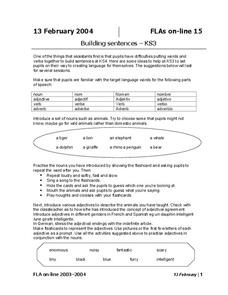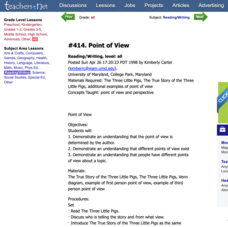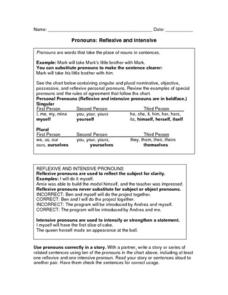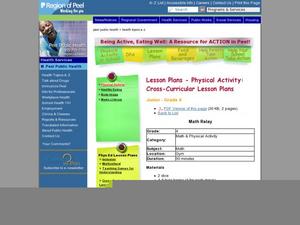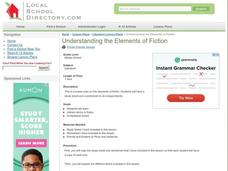Curated OER
Knowledge or Instinct? Jack London's "To Build a Fire"
Young scholars closely read " To Build a Fire," to explore the use of narrative point of view and debate the distinction between knowledge and instinct. The elements of literary naturalism and how they relate to Jack London's work is...
Curated OER
Building Sentences
Whether working with pupils in their primary language or language learners, the exercises included in this resource will encourage your pupils to build more complex sentences. Using color-coded cards of nouns, adjectives, verbs, and...
Curated OER
Direct & Indirect Object Pronouns
There is a wealth of information provided here about direct and indirect object pronouns. Consider breaking these complex grammatical concepts into smaller chunks so that your Spanish language learners do not become overwhelmed. The At a...
Curated OER
The Scarlet Pimpernel: Concept Analysis
Considering The Scarlet Pimpernel as part of your curriculum? Check out this overview that provides a brief summary of the plot of Baroness Orczy's novel and a discussion of some of the issues presented by her tale of the french...
Curated OER
Tenses and Conjugation
Present, past, future, present perfect, past perfect, and future perfect. Past, active, indicative. Need a worksheet that not only defines verb forms, but demonstrates how to use them? If you want a resource for class members needing...
Teachers.net
Point of View
Work with your class on point of view by reading "The Three Little Pigs." Learners demonstrate an understanding that the point of view is determined by the author and that different points of view exist. They then read a different short...
Curated OER
Pronouns: Reflexive and Intensive
What is the difference between reflexive and intensive pronouns? To find out, review the definitions and examples for various types of pronouns. Then complete several activities that help the class learn to recognize and use pronouns....
Curated OER
Math Relay
This is really a math review for older elementary learners to practice making equations using adding, subtracting, multiplying, and dividing in a fun way. They get to move around and play with hula hoops, bean bags, balls, and jump...
Curated OER
Understanding the Elements of Fiction
Inform your class on the elements of fiction: themes, settings, characters, plots, dialogue, narration, flashback, clues, climax, resolution. They write the definitions of the terms on the worksheet provided.l Tip: Have them write a...
Curated OER
Lord of the Flies: Chapter 1 Reading and Study Guide
In this comprehension check worksheet, students define 13 vocabulary words, define 5 literary terms, and respond to 23 short answer questions pertaining to chapter 1 of The Lord of the Flies in order to help them better understand the...
Curated OER
Evaluating Information Quality
Students evaluate information they are given and identify the quality of the information as fact, fiction, and point of view. In this information quality lesson plan, students also discuss how they can pick out good information verses...
Curated OER
Direct and Indirect Speech
The focus of this language arts worksheet are the differences between direct and indirect speech. Learners efer to a story and analyze examples of direct or indirect speech, note verb tense changes and converting five sentences.
Curated OER
Establishing a Point of View in Narratives
Fourth graders investigate the concept and take the opportunity to both identify and to construct point of view in narratives. Additionally, 4th graders practice identifying and sequencing main events.
Curated OER
Study Guide for "The Open Window"
For this reading and study guide worksheet, young scholars define 6 vocabulary words, define 6 literary terms, and respond to 14 short answer questions pertaining to "The Open Window" by Saki.
Curated OER
Study Guide for Liam O'Flaherty's "The Sniper"
In this reading and study guide worksheet, students define 9 vocabulary words, define 8 literary terms, and respond to 13 short answer questions pertaining to "The Sniper" by Liam O'Flaherty.
Curated OER
Study Guide: The Sniper
In this study guide instructional activity, students must define vocabulary and literary terms found in the short story "The Sniper". Students cite examples of literary terms usage and answer comprehension questions.
Curated OER
Peer Editing
Sudents read and critique three of their fellow classmates' science fiction short stories on three consecutive days for mechanics, short story elements, style, and informational elements.
Curated OER
Star for a Day Name Fun
High schoolers practice introductions in a foreign language. In this foreign language lesson, students get a card with a star that they have to pretend to be. They walk around the room introducing themselves and asking other's names in a...
Curated OER
Word Work
In this word work activity, students match adjectives with their meanings and fill in the blanks to sentences about wishes. Students complete 21 problems.
Curated OER
How Worldly Are You?
Sixth graders locate and map six components to have a working knowledge of maps. In this map skills lesson, 6th graders define the six map components and work in groups to draw a map using the components. Students read a related...
Curated OER
Imagining Your Science Fiction Short Story
Twelfth graders brainstorm ideas for their own science fiction story. Using worksheets, they sketch the plot and setting for their story. They create appropriate characters and develop their interactions among each other. They share...
Learning Station
Point of View—Picking Favorites
For this writing worksheet, learners discover how a story can change depending on the point of view the writer has chosen. Students read several excerpts from stories and respond in writing to how they are different.
Curated OER
Number the Stars, Lesson 11
Students analyze point of view in the novel Number the Stars. Their writing prompt is how would this chapter(11) be different if Peter were telling the story? Students create a class concept web about pride on the board.
Curated OER
Data Analysis and Bias
In this probability and statistics worksheet, students determine when a collected data or a graph of the data could be biased. The one page worksheet contains four multiple choice questions. Answers are included.

